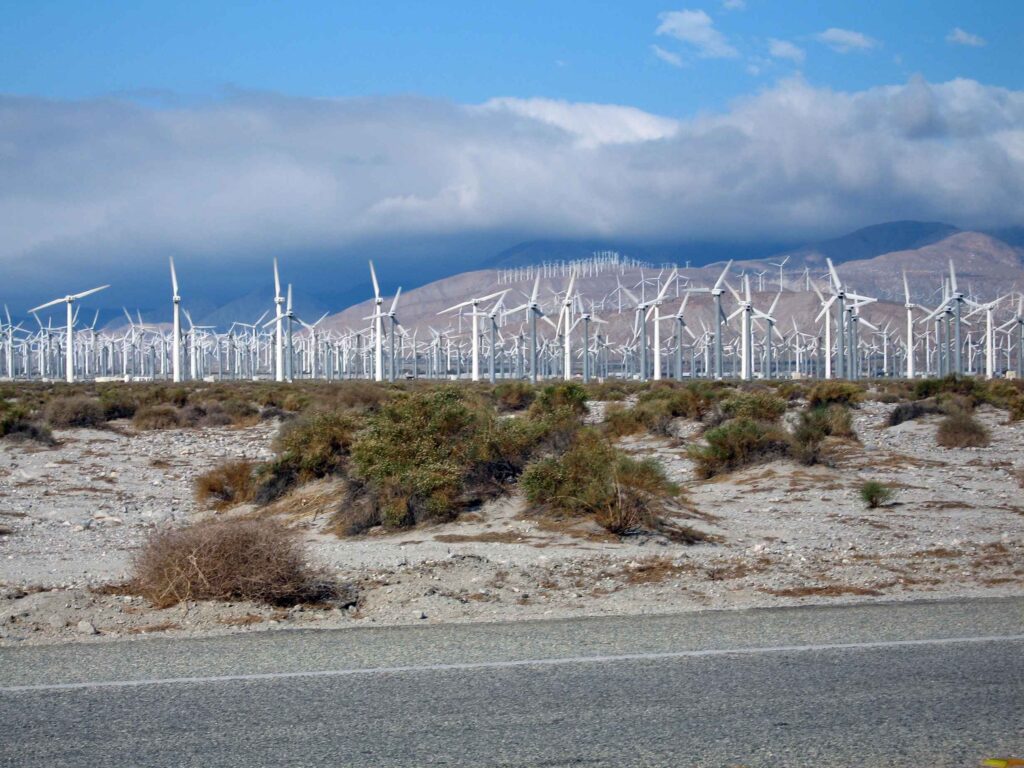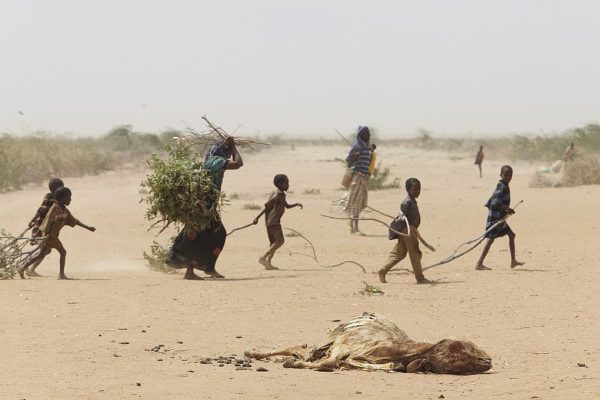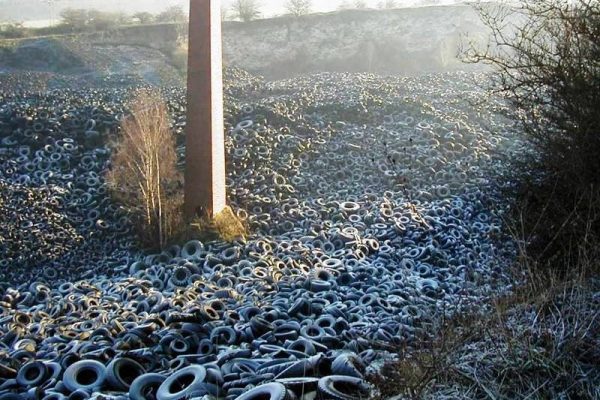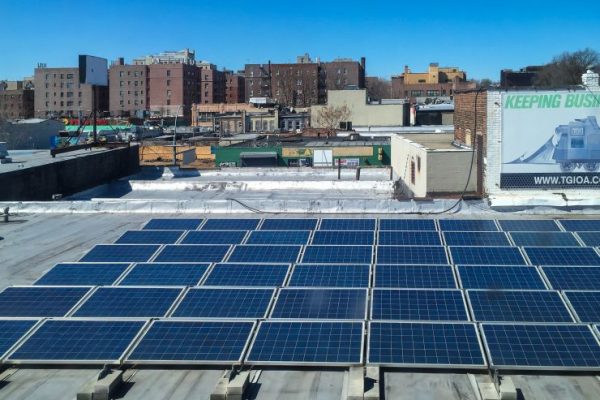Renewable energy seems set to repeat many of the mistakes of fossil fuels. Though wind and solar power will not degrade the conditions for life on planet earth, the geography and corporate structure of these industries concentrate benefits and exclude communities in the style of Big Oil. The neighbors tend to notice—and to complain. So-called “renewable energy rebels” want a slice of revenues, or wind farms that are smaller or farther away. These “not-in-my-backyard” protests are delaying and blocking projects from Spain to Germany to the United States. To the extent that these movements succeed, they undercut the planet-saving ideal these technologies promised to all of us.
A Spanish village I will call Sereno, possibly the most turbine-surrounded community in the world, exemplifies this lesson. In 2006 residents rebelled against plans for hundreds of turbines to be installed only hundreds of meters from them. They anticipated ugly sights and sounds: ninety-meter steel towers and sixty-meter fiberglass blades bristling and pulsating above wheat and cattle. Their protest failed, but—alongside similar movements elsewhere and the economic crisis of southern Europe—it effectively slowed the construction of new turbines in the entire autonomous region of Andalusia. Meanwhile, the residents—with whom I shared many drinks while visiting as an anthropologist—nurse their old grudges and discover new ones: bird kill, the absence of jobs in turbine maintenance, lack of once-anticipated tourism jobs, and deals whereby landowners collect royalties from each wind turbine. Some of these problems can be solved: a wind commons, for example, would take power away from the handful of old families who control those wheat fields and pastures. The 800 landless residents of Sereno—many of whom are poor and technically squatters—might then collect revenue and support the energy transition. This is worth fighting for.
But, for the purposes of the present argument, let us say that that form of social justice does not take immediate hold. Might residents of the next Sereno essentially lump it for the sake of planetary social justice? Without saying as much, proponents of wind power tend to hope for this. To persuade people, we tend to downplay the aesthetic harm, the diversion of benefits, and other negatives. Instead, we should level with the inhabitants of the world’s wind corridors. Absent significant reform, local communities will lose something they value in the energy transition. We should emphasize that loss—ennoble it, even—by calling it “sacrifice.” As a kind of retrospective experiment, I began to ask Sereneños about their willingness to sacrifice for the common good. Some would sacrifice, I learned, but they would also demand that the common good was, indeed, both common and good. Wind farms have not impressed the villagers as being either. Proponents of clean energy must listen here: we can present and organize saving the planet in a way that inspires more devotion, cooperation, and self-abnegation—ultimately, in a way that plays to the better nature of windblown people.
Sereneños describe themselves as selfish. The village’s most popular restaurant denies credit and advertises the fact with “No se fia” (You are not trusted) signs behind the bar. Across the bar men loudly opine and argue about finances with exaggerated force—right down to their body language. My drinking mates indicate revenue by rubbing two fingers together, and payment by wrapping the table with their knuckles. They see corruption everywhere. Greed, they believe, moves all politics and politicians, and many a person-on-the-street. “I have no friends,” says one drinker, tapping his wallet, “only bills.”
One might guess that Sereneños are not temperamentally inclined to make sacrifices. However, they do use the word occasionally. I begin to hear it on a series of warm evenings in the early fall. Mateo, a wiry griller at a restaurant, is telling me about the summer season that just concluded. It was hot: 102°F in the street and 113°F in the kitchen. This work is slavery, prison, and a sacrifice, he says. One drinker picks up this theme a few nights later while describing the way that employers overwork their waitstaff illegally and the state ignores wage theft. “Hospitality is sacrificed,” he says sadly. I puzzle over this grammatical construction. Sereno is the object—not the agent—of sacrifice.
This presents the first obstacle to my proposition: Sereneños do not feel empowered enough to choose to sacrifice. So much has been taken from them that they believe they have nothing left to give. My neighbors squat between estates owned by others. To make matters worse, the extensive cattle farms create almost no employment. It seems insensitive to ask that people already at the margins part with what little they have.
Still, I press the point timidly with my most forgiving informant, Carolina. What if the wind companies had actually asked the people—giving them the option to accept the turbines for nothing? Would the village have said “yes”? At this absurdity, Carolina begins to lose her cool. “That cannot be!” she remonstrates. Am I talking about “altruism for the planet”? she asks in disbelief. “If only the landowners will gain, I say ‘no!’ We are all altruists or there are no turbines.” Carolina’s eyes blaze while her husband, Daniel, giggles in agreement. They have foregrounded another impediment to sacrifice: an ethic of equality. Those with little might sacrifice for each other, but not for those with more. If the energy transition is to proceed through sacrifice, then rich and poor must sacrifice together—and they must freely choose to do so. Local history provides no precedent for such a pact.
A month later, I have lunch with Carolina and Daniel again. Because my wife and daughter are visiting from New Jersey, our conversation turns to Donald Trump, then to immigration. We all oppose his fantasy of a border wall between the United States and Mexico. Then discussion turns to immigration in Spain. Though Spain has a natural wall, the Strait, people still cross in rafts and boats. Daniel used to help those people, Carolina says with pride. Migrants disembarked on the beach and snuck four kilometers inland to Arabic-speaking Daniel, who grew up in Spanish Morocco. Daniel distributed food, water, clothes, and some money. Many others lent a hand, either giving money directly or passing it through Daniel. No one informed the immigration authorities. Once, while Daniel was transporting two Moroccans in the back seat of his small Renault, the highway patrol stopped him. They let him pass, however, and the migrants reached their contact who trucked them to the labor-intensive horticultural operations in Almería. Carolina also supported the operation. It continued until roughly 2005, when stiffer penalties drove migrants further underground. Professional, often mercenary traffickers took over from Daniel’s underground railroad.
Why did Daniel and Carolina take these risks? Daniel answers this question matter-of-factly, “It’s solidaridad [solidarity] more than anything. You see the people who come. Here, you must help.” Carolina continues, “The Spanish people are very solidaristic,” proving the point by using an adjective that hardly translates into English. This view runs deep in Sereno. Andrés, another Sereneño, says he would at least pass a water bottle to a migrant if he had a chance. In fact, he remembers that he gave a lift to one clandestine newcomer from Sereno all the way to Algeciras. My informants emphasize the face-to-face nature of these interactions and the obligation to help the human being standing before them. Rather than using the term “sacrifice,” Sereneños understand solidarity far better.
I encounter African migrants, or traces of their presence, myself. A boat washes up on the beach where I swim and seven abandoned life jackets quantify the arrivals. Police, I learn, picked two up by the coastal supermarket. The next day, Ana, another informant, tells me her classmates watched men who appeared to be Moroccan running on the same stretch of beach. No one is in a position to help, but these events trigger memories of solidary acts otherwise too normal to remember. Ana’s mother, Rosa, recalls meeting a stranger five months prior outside of the village. She called her husband, who told her to help him. She went home for food, but by the time she returned—with cheese, bread, and yogurt—the migrant had fled. Her sister-in-law provided solidarity to greater effect. In 2001, Rosa recounts to me, a boat arrived from Morocco. Three people had died on it. Authorities took some survivors to the hospital and the healthier ones to the police station, where Rosa’s sister-in-law was handling a personal matter. She encountered an infant crying desperately with hunger. Its mother, under treatment for hypothermia, could not breastfeed. The sister-in-law, who was also nursing, promptly offered her breast. Sereneños explain this borderless generosity as a debt repaid: Spaniards fled to France and Latin America under Franco and now it is their turn to take in refugees. If global solidarity already takes the form of bread and cheese, might it also manifest as steel and fiberglass?
I put this question before the region’s most influential anti-turbine activist, José Tirado. A three-hour bus ride takes me to Seville, where the renewable energy rebel—who is also an artist—sits in a dim studio. Bicycles, equipped with carriers and a baby seat (for his grandchild), are crammed in the back. “The planet belongs to all of us,” he tells me, and Spain should admit everyone who appears at her doorstep. The person in economic “exile,” Tirado continues, is no less human than the wealthy tourists taking ferries between Tarifa and Tangier. Borders, he has long felt, discriminate, and often kill. Around 2000 Tirado wanted to provide “primary assistance to a human being.” At that time, living close to Sereno, he began transporting people to contacts in Córdoba and Madrid. Alongside his communist friends, he served in Inmigración sin Muertos (Immigration without Deaths), the network of Daniel, Carolina, and other solidary people in and beyond Sereno.
I ask Tirado if solidarity also includes less personal, more institutional means of saving lives in and around the Strait. Yes, he answers, that is why he makes films about migration. In 2007 he shot La Liga de los Olvidados (The League of the Forgotten). The camera follows young African and South American men as they play soccer on dirt and concrete fields. Tirado hopes his audiences will reduce the challenges they face by voting and protesting for immigrants’ rights. Now I ask Tirado about another form of cross-Strait solidarity: For the sake of Africans suffering from European fossil fuel collaboration, could he accept wind farms? He adjusts the beanie he is wearing, considering the far-fetched question. Well, he begins, turbines might qualify as a kind of “planetary assistance,” but the effort would be “only environmentalist.” One would need a “vision of the whole,” that is, a red and green plan to “share wealth” by locating turbines fairly. We return to where we began: poor people should not sacrifice their views and economic opportunities while rich people gain. But, I suggest, a full energy transition does not give us the luxury of selecting sites according to social justice. We may need turbines everywhere. Tirado acknowledges this, but poses that one could organize widespread wind farms such that each community generated electricity for itself. If this were the case, Sereno would live with dozens, not hundreds, of steel machines.
This local energy transition amounts to a form of secession or “grid defection” by those fortunate enough to live in energy-rich places. Urban people do not have this option, as apartment buildings have too small of roofs for the number of inhabitants. Dense cities, moreover, do not accommodate sixty-meter blades. And people should live in cities, I lecture Tirado, because transportation is sustainable there. We glance at the bicycles in the back of the room. The energy transition, therefore, necessitates spatial unevenness and disproportionate burdens. The countryside will always have to subsidize those who live in urban areas. And, to prevent climate-driven exile from Africa, Europe’s rural people have to make this sacrifice.
Tirado is momentarily stumped. Then he levels a charge I cannot answer: wind turbines do not cut carbon emissions, stabilize the climate, or help anyone who needs help in any immediate way. If nothing else changes, the region that installs a thousand turbines today will emit carbon at the same rate tomorrow. When it comes to mitigating climate change, the only quantity that matters is the absolute tonnage of CO2 and other greenhouse gases spewed into the atmosphere every day. Blades can reduce carbon emissions only indirectly—if and only if people consuming wind or solar energy simultaneously burn less fossil fuel.
Though Spain passed legislation in May 2021 to end fossil fuel production by 2042, the country has not made these substitutions—and Tirado knows it. In its first decade, large-scale wind power went hand-in-hand with pollution. Between 1998 and 2008, grid density (the proportion of electricity generated from wind) rose from 1 percent to 10 percent while national carbon emissions soared from 242 megatons to 338 megatons, a 40 percent jump. The country produced more electricity through every means, and Spaniards ran that voltage through household appliances and all manner of millennial gadgetry. Then, in 2008, the economic crisis changed things. As the economy tanked, industry cut consumption, and the energy sector allocated those cuts to coal (Spanish governments had been trying to shut down coal mines since the 1990s). Since 2008 rising grid density has corresponded with lower emissions. By 2018—at 19 percent grid density and much higher electrical consumption—the nation’s CO2 contribution had returned to roughly its 1998 level. As a means of saving the planet, wind has been a wash, only saved from complete failure by prolonged recession.
Spain would have polluted still more, though, if not for wind farms. At this, Tirado gives me a withering look: “Let’s not play games.” Rather than saving the world, blades have merely allowed middle-class Spaniards to buy microwaves and smartphones. I have seen no evidence of organized electricity conservation—no “save a watt” signs by light switches, no motion sensors in corridors. “Negawatt,” or the absence of electric consumption, translates into negavatio in Spanish, but the term is hardly used. My assurance drains as I realize that Sereneños—were they to sacrifice and practice solidarity—would be doing so for Spain’s pleasure rather than for the most marginalized people of the world. Tirado wins the argument.
My search for people willing to endure the costs and forgo the benefits of turbines for the sake of the common, planetary good only partly failed. I did not find anyone willing to undertake that sacrifice, but I also discovered that Sereno’s wind farms do not serve the common good. Occasionally people asked me, “Why, if these turbines are producing clean energy, is the oil refinery in Algeciras still polluting our air?” Though the question conflated different uses of energy, it contained an essential truth. Rather than replacing fossil fuels, wind farms are supplementing them. Spain’s nuclear plants, which also worry the villagers, continue splitting atoms almost at an even clip. At best, renewables hold pollution to a steady stream. This is the global story of wind and solar power. In 2012 every 10 megawatts of renewably generated electricity displaced at most 1 megawatt derived from fossil fuels. Meanwhile, panels and blades illuminate empty rooms, cool half-empty fridges, and otherwise fuel high-energy, wasteful lifestyles. Certainly, electric companies—in just about any jurisdiction—do not want people to buy fewer megawatts. Their profits depend on over-illumination and over-used electrodomésticos. Sereneños are wise to wonder why they should sacrifice their view, landscape, and tranquility for enrichment elsewhere.
Under different circumstances, my neighbors might make that sacrifice. If, in the spirit of helping refugees, wind companies had asked Sereneños for their assistance, the village would have considered it. They would have considered the sacrifice seriously if those inhabiting drought-prone North Africa or flood-prone South Asia had made the pitch in the vernacular of solidarity. Such an appeal would have fallen within Sereno’s traditions. But nothing in the political and economic arrangements of wind power facilitates person-to-person humanity. Instead, firms impose steel. Traditional Sereneños harden their hearts and turn their backs. We who support a large-scale energy transition away from fossil fuels are missing an opportunity. We squander the goodwill and generosity of people in windy, sunny places—a resource that is ample but far scarcer than wind and sunlight.
Editor’s Note: This essay is adapted from Who Owns the Wind? Climate Crisis and the Hope of Renewable Energy, published by Verso Books.






